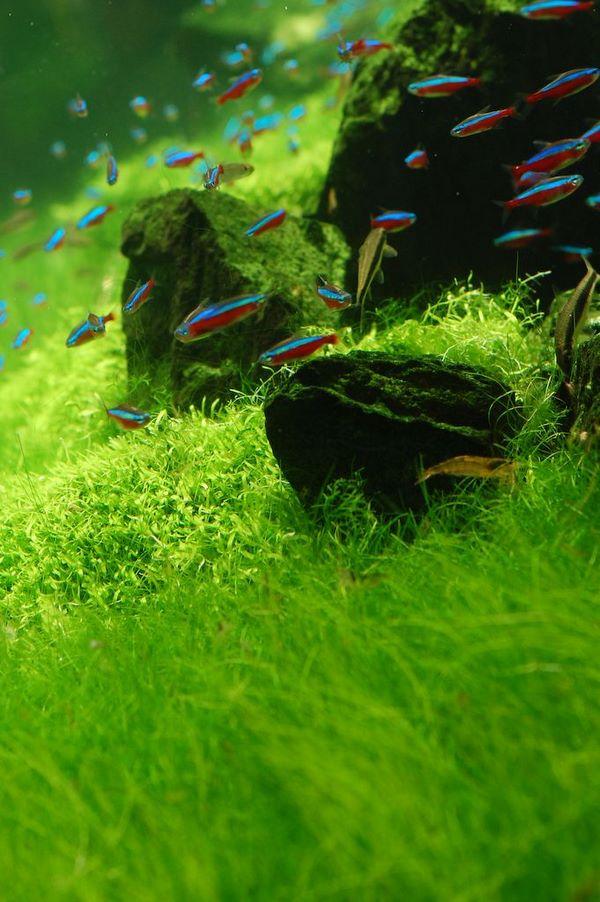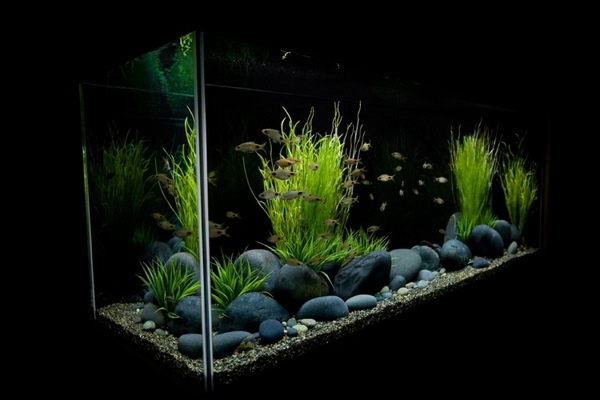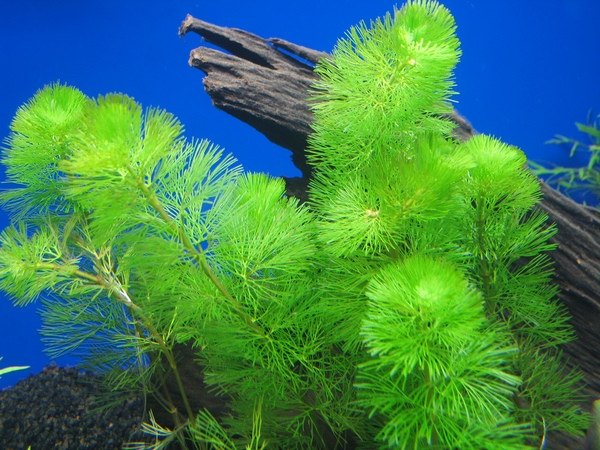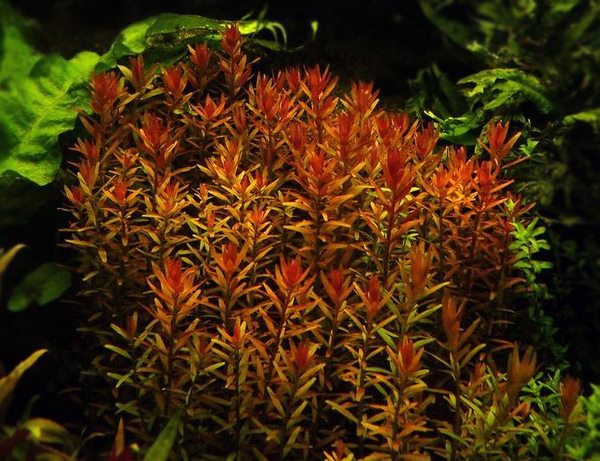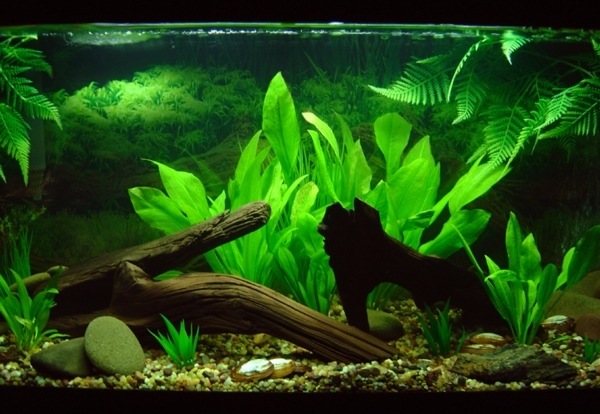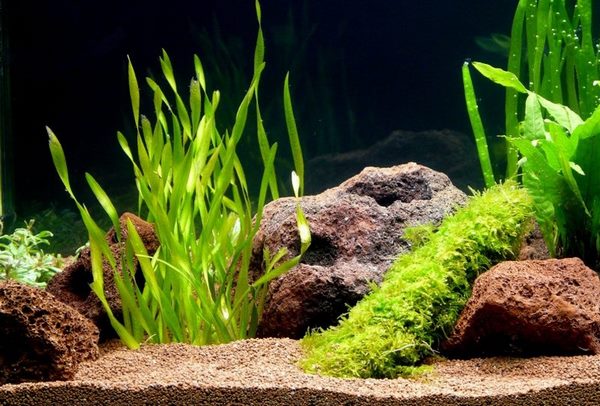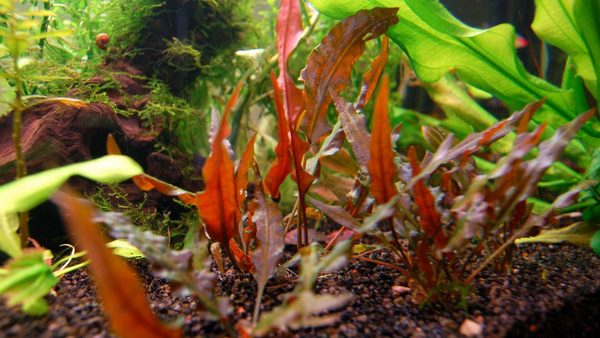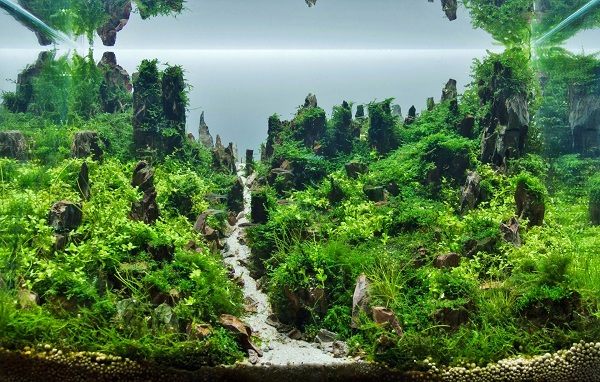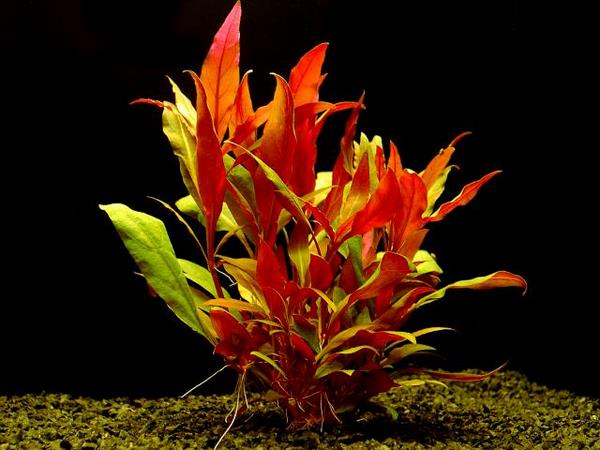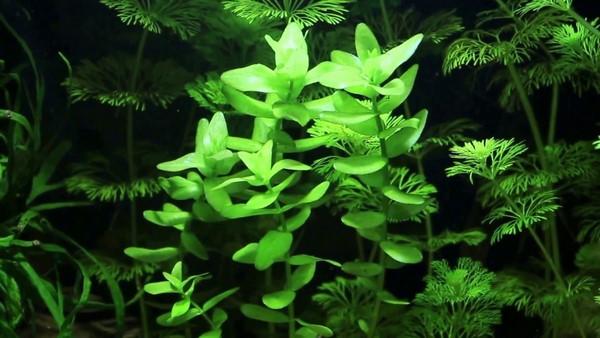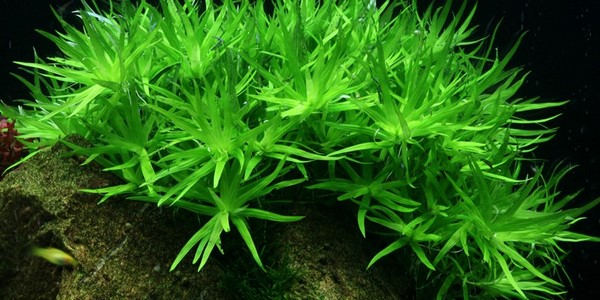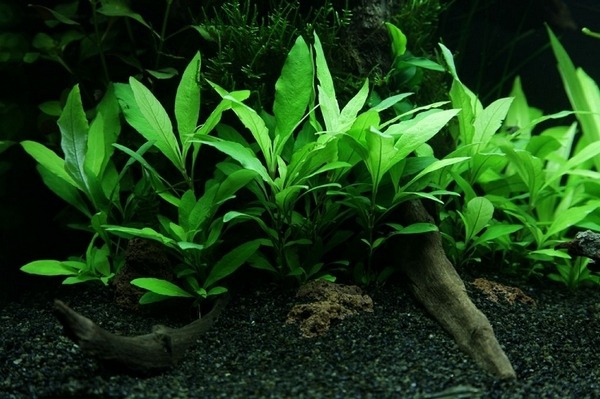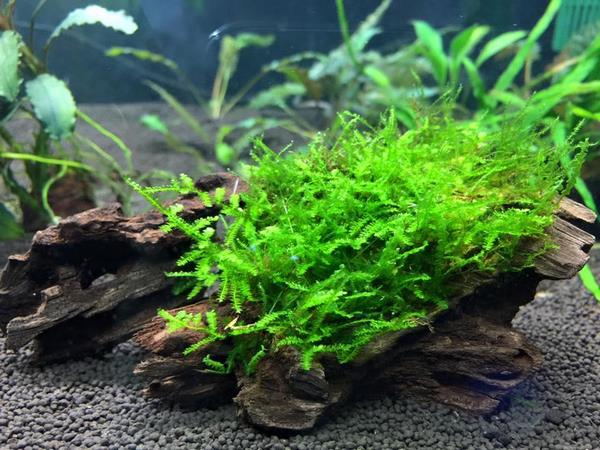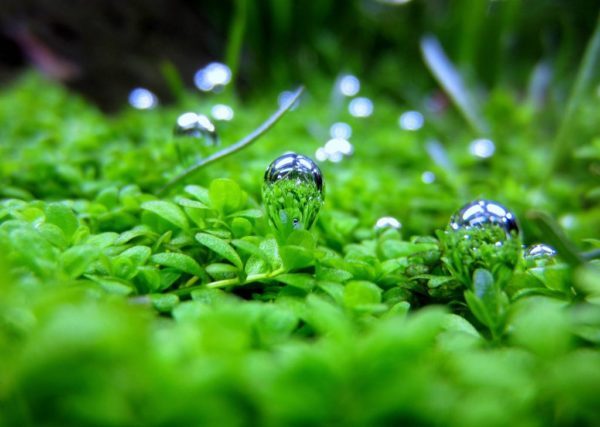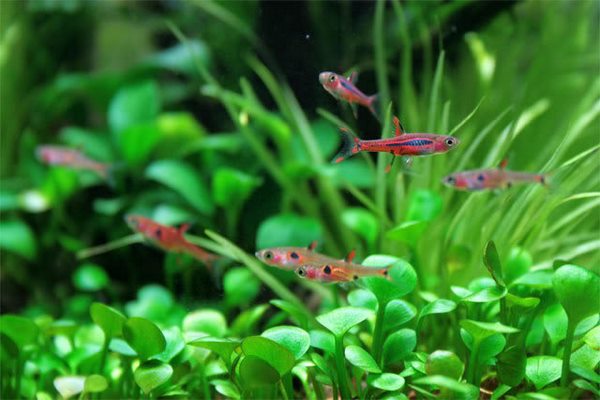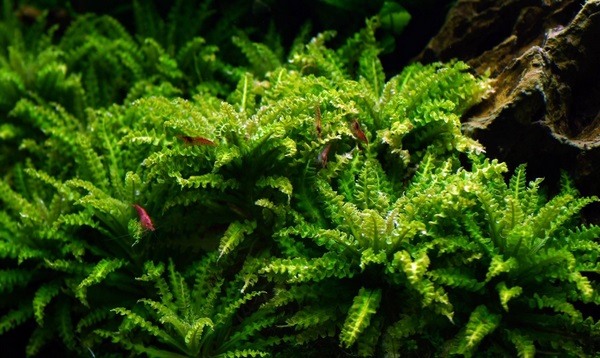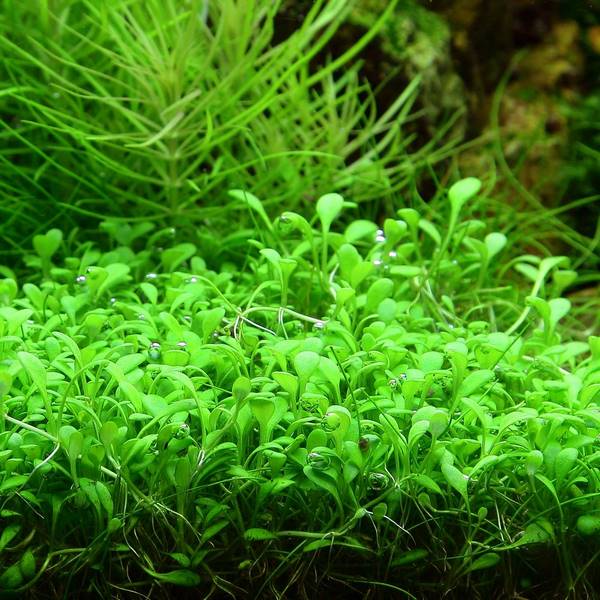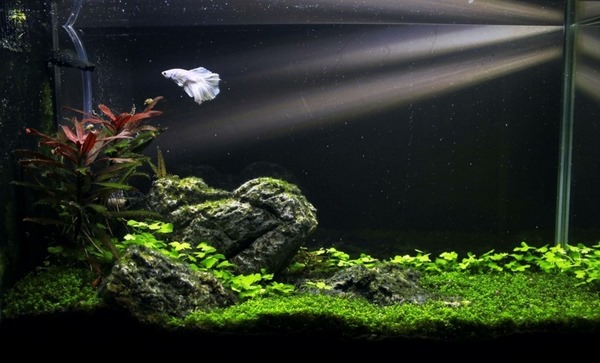How to choose plants for aquascapes – this is one of the most important questions when one decides to start his first (or next) aquascaping project. Aquascapes combine a number of components and they have to be carefully chosen to create a balanced environment and an impression for re-creating a part of nature. This requires well arranged aquatic plants, balance between colors and plant shapes, suitable hardscape elements (if used) and favorable environment for fish.
When starting your first aquascaping project you need to remember that the main idea is to use minimum decorative elements to achieve maximum expressiveness. You need to follow the laws of exposition, perspective and you may be surprised, but there is a lot of mathematics involved in the design of a spectacular aquarium.
Great importance in the design of a natural aquarium is given to plants as they are the “lungs” of the aquarium. The species diversity and the arrangement (as in the Dutch style aquarium) is essential, but the construction of a harmonious picture is even more important. Often, an aquascape is based on only one or two species. Ground covering species have a special role and they are an element which gives the base in most aquascaping styles. In the process of photosynthesis, aquarium plants secrete oxygen and guarantee a stable biological balance.
What is important to know when choosing plants for aquascapes
A beginner usually thinks that plants in an aquarium are unnecessary problems. Actually for the normal life of plants in the aquarium, as for fish, the main thing is to create optimal conditions. For plants – this is achieved by selecting the proper lighting, neutral soil, the correct concentration of fertilizers and proper water parameters.
The intensity of illumination and the availability of daylight have a very important role for plants. After all, the process of photosynthesis will not happen without light. Some species need a lot of lighting, some do not.
In general, we can say that the soil should be neutral with a thickness of 5 to 7 cm, light and fine. You need to provide enough thickness of soil to allow plants to root well.
Fertilizers provide macro and micro elements – nitrate, phosphate, potassium,etc. There are many plant fertilizers on the market – some are liquid, others are tablets. Fertilizers provide a complex of essential nutrients. They protect and strengthen new plants, promote the formation of roots, improve root survival during planting and transplantation, etc.
How many plants do you need in an aquarium? The most important thing when choosing plants for aquascapes is not to overdo the design. As per experts, a good, stable aquarium should consist of 50-75% plants. Of course, this is not a strict rule or a dogma but the practice shows that this is the percentage for a healthy environment.
Types of plants for aquascapes – beginner’s guide
Like fish, there is a huge number of plants for aquascapes and every species has a place in the aquarium. Higher and large leaved species are ideal as background plants, smaller species can be used in the middle plan while low-growing species should be placed in the foreground. However, there are no strict rules what the species for the foreground or the background are, and it is often better to create a visually pleasing mix. Generally speaking, large plants should be placed behind small ones, this is for obvious reasons, but they can be grouped and arranged in various ways to create an interesting aquascape. Although it is tempting to use many different species, it is often much easier and more efficient to use a limited number of species in large groups. Let’s take a closer look at the different groups of plants for aquascapes.
Background plants for aquascaping
Aquascaping plants suitable for background are usually arranged along the back wall of the aquarium. They look impressive and create dynamics. You can afford some extravagance with background plants when you want to add a sense of depth and texture. Depending on the goal and the particular design the plants can be arranged on the sides of the aquarium to create a more closed environment and serve as “boundaries”. Here are some of the most popular species:
Rotala rotundifolia –is a popular stem plant with small leaves in pale orange and green or reddish pink shade. It requires a lot of light but otherwise is not demanding and grows pretty quickly.
Amazon sword (Echinodorus) is a good choice for large aquariums as it grows quite tall. This plant is a good focal point and offers the advantage of being low maintenance. This aquascaping plant does very well in medium to low lighting conditions.
Vallisneria plant has many different species which vary in length but are easy to grow. The most popular are Vallisneria spiralis, Vallisneria tortifolia, Vallisneria gigantean, etc. All the varieties of Vallisneria plant are doing well in medium to low lighting conditions and become dense quite quickly. You need to watch out as they can take over the entire tank and remove some of the runners when necessary.
Cryptocoryne is one of the plants that prefers low lighting and an ideal choice for beginners and those who want low maintenance aquarium plants. It groes relatively slow and if given enough time will develop into large and dense bushes.
Cabomba, also known as fanwort, is a magnificent aquarium plant with a beautiful fluffy look. It requires very good lighting. The green variety is most popular but red and purple varieties can be used as well as color accents in the aquarium.
In a wider aquarium, species with large leaves, such as large species of Echinodorus can be used as a group or as a single plant. Bushy stem plants, such as Limnophila or Myriophyllum, look great in the background when grouped and combined with tall, stalk plants with small leaves such as Rotala, Egeria, Bacopa or Ludwigia.
Mid-ground plants for aquascaping
Aquascaping plants suitable for the mid-ground are usually used to blend the foreground and background. Mid-ground species are not fast growers and they can be cut to different heights to create the transition from higher species in the background towards the low plants in the foreground. Stalked plants with large and long leaves are an excellent choice.
Alternanthera reineckii Roseafolia, also known as Magenta water hedge and Alternanthera Osiris, is a magnificent plant and the perfect choice when you want to create a contrast and a color accent. It is undemanding and feel equally well in hard and soft water.
Bacopa comes in different varieties – Bacopa australis, Bacopa caroliniana, Bacopa monnieri (moneywort) – and has been used in aquascaping for many years. It requires relatively good lighting conditions but apart from that this aquatic plant is not very demanding. It is a slow grower and looks best when planted in small groups.
Heteranthera zosterifolia is an aquarium plant originating from South America. It is a beautiful plant which forms many side shoots. Stems can reach up to 30-50 cm tall and 6-12 cm wide. You need to prune the plant as it becomes very compact and light cannot reach the lower leaves.
Hygrophila comes in many varieties – Hygrophila corymbosa, Hygrophila polysperma, Hygrophila pinnatifida, Hygrophila difformis and the different varieties originate from different parts of the world. This is a very good aquatic plant for beginners in aquascaping because it is undemanding and will grow in any conditions. Some varieties are fast growing while others grow at moderate rate. Depending on the variety the color, shape and length of the leaves will vary as well.
Lysimachia Nummularia Aurea, also known as Creeping Jenny and Lloydiella, is one of the aquatic plants which adapts ti almost any environment. It is undemanding and easy to grow, and reaches a moderate height – up to 16 inches (40 cm). Creeping Jenny tolerates soft or hard water and will grow very well if kept in bright lighting.
Plants that grow on wooden and porous rocks are also suitable for the middle plan. Anubias, Bolbitis, Fontinalis, Microsorium, and Vesicularia – all of these can be used. Single plants will look well if they have enough space around. The medium plan is also the ideal place for using decorative elements together with plants. Rocks and wood can be used to create visual dividers between the different areas and focal points.
Foreground plants for aquascaping
Aquatic plants for the foreground of your aquascape will help you create an impressive design and this is the most difficult task. Usually for the design of the foreground, low-growth species are used, which reach a height up to 10 cm high, because higher plants in the foreground will not only cover the background, but also visually make the aquarium smaller. Here are some options which are a good choice for beginners:
Java Moss (Vesicularia Dubyana) is one of the most popular aquarium plants. It grows quickly like a weed and is often used to form a carpet-like look in the aquarium, it is very durable and undemanding. The plant grows quickly in medium light conditions but you should know that it needs to be anchored to a hardscape element or it may float to the top of your aquarium.
Dwarf Baby Tears (Hemianthus callitrichoides), also known as Cuba, Hemianthus Cuba, pear grass or HC, is the smallest and one of the most charming aquatic plants for aquascpes. It is the perfect foreground plant which forms a bright, vibrant, green carpet. The best conditions for the plant are bright, direct lighting and a rich nutrient base and it will thrive in your aquarium.
Marsilea Minuta, also known as Small Water Clover, Dwarf Water Clover, is among the most popular aquarium foreground plants. You can easily recognize it as it looks like clover. The plant tolerates most environments and lighting conditions. Medium lighting is the best but it will grow well in low lighting as well.
Pogostemon helferi is a unique plant for the foreground of your aquarium. Discovered by aquarists in Thailand, the plant has a great visual appeal and beautiful zig-zag shaped leaves. The vivid green color makes the carpet of the aquarium look strikingly impressive.
Glossostigma Elatinoides, popular as Small mud-mat or Glosso, is one of the smallest aquarium plants which forms a dense green carpet and is a great choice for the aquarium foregrounds. It is especially valued for Japanese styled aquascapes but you should know that the plant is demanding and difficult to care for. It needs a lot of light and should not be shaded by other plants.
Obviously, these are just a few of the most popular aquatic plants for aquascapes. In conclusion, we can give you some useful tips to follow when designing your first aquascape.
- It is better to plant different species in groups and in odd numbers.
- Position plants with heavy leaves at the edges of the aquarium.
- It is advisable to avoid dark colored plants (red or green) in the center of the aquarium. Such species will look better in the corners of the tank.
- Combine plants and hardscape in a harmonious way trying to create visual contrasts between light and dark.
- Plan carefully the composition and the elements of your aquascaping project. Draw a sketch to visualize the size and place of the hardscape elements – rocks and wood – and the arrangement of plants around them.
Do not be afraid to experiment, remember that aquascaping is a process which requires patience and devotion, but the most important is to enjoy every step of this process!


